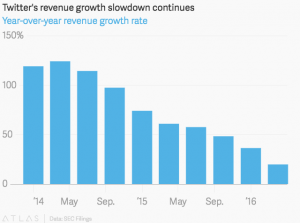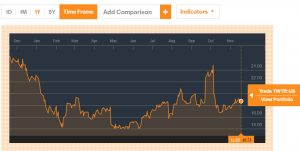Going through Twitter’s latest mute feature update, and observing the background proceedings leading to it, I realized how Twitter is at the end of its rope!
It was in February 2015 that Verge had released a sensational report about Twitter’s chronic problems with harassment and abuse and how trolls are costing Twitter users. The report quoted an internal memo by the then-CEO Twitter, Dick Costolo making a frank acknowledgement of Twitter’s slowness to adopt tools to combat trolls:
“We suck at dealing with abuse and trolls on the platform and we’ve sucked at it for years. It’s no secret and the rest of the world talks about it every day. We lose core user after core user by not addressing simple trolling issues that they face every day.”
From this internal acknowledgement of issues gone public in early 2015, to Twitter’s unsuccessful attempts at selling in late 2016, it’s been quite a happening period at Twitter. The microblogging service continues to struggle with its efforts to keep the train on tracks.
On Tuesday, Twitter announced an expansion of mute feature to the notifications tab, a subtle reminder of its ongoing battle against the susceptibility of online abuse at the medium.
Want to stop getting notifications for Tweets that contain certain words, usernames, or hashtags? We’re giving you that control. pic.twitter.com/awoNHUYbTG
— Safety (@safety) November 15, 2016
The expanded “mute” feature enables users to eliminate, or mute, notifications based on keywords, phrases or entire conversations they are not interested in seeing. Muting will remove these Tweets from the Notifications tab, push notifications, SMS, and email notifications.
This update has only been one of the many tweaks Twitter has brought in lately to address the platform’s issue of abuse, bullying and harassment.
The question arises, why has it become important for Twitter only now to address the issue of trolling?
Currently, Twitter boasts of some pretty figures on the board:
Monthly active users: 317 Million
Tweets per day: 500 Million
Active users on mobile: 82%
Languages supported: 40+
And if it amounts to anything, the platform has the blessings of the Church too!
According to the Vatican, you can reduce the time you spend in purgatory by following the Pope on Twitter.
Another study claims that Twitter is more addictive than cigarettes and alcohol.
Yet with all these years, stats & claims under its belt, Twitter’s best description to date, as a company, remains to be the statement by the CEO of Facebook Mark Zuckerberg. Nick Bilton’s book, “Hatching Twitter: A True Story of Money, Power, Friendship, and Betrayal,” quotes Zuckerberg:
“[Twitter is] such as mess — it’s as if they drove a clown car into a gold mine and fell in.”
Twitter – with its mission statement: To give everyone the power to create and share ideas and information instantly, without barriers – has been similar to a few late last millennium’s dotcom companies. All we see is a great idea in the background, but no clear path for monetization in the foreground.
Venture capitalist Paul Graham opined re future of Twitter
There is a valuable idea inside Twitter. But Twitter won’t be the company that realizes it.
— Paul Graham (@paulg) August 18, 2016
It’s been exactly three years since Twitter went public. The IPO has kept it afloat for a while, but the company has been bleeding cash and in desperate need of a new direction.
Earlier this year, MoffettNathanson analyst Michael Nathanson downgraded his rating on Twitter’s stock. “Advertiser fatigue” being one key driver behind his downgrade of the social media stock.
“Twitter is now not only dealing with user fatigue, but advertiser fatigue as well”
In September this year, Twitter reported the slowest quarter of revenue growth since going public. This is just before the rumors of platform’s possible sale began making rounds in the industry.
The absence of a clear revenue model has been increasingly evident through Twitter’s visible struggle to remain afloat as a standalone entity. The stock prices continually coming down, and picking up only at the rumors of a possible sale, tell a lot to any stock observer.
The go-to social platform for real-time & guerrilla marketers, with large, distributed conversations happening on every corner of the network, has been pinning its hope at a possible acquisition. However, the possibilities have been few and far between.
Observes opine that in order to claim a successful deal, Twitter needs to do some housekeeping. The San Francisco-based company still has a lot to figure out:
- Twitter still struggles with abuse, hate speech and safety concerns on its platform and has been rather inefficient to figure out the right way to deal with it.
- The platform’s identity crisis sees no end in sight: It’s a news app, a social media company, and a live-streaming service, all rolled into one.
- Twitter has promised – without prior homework – and then failed to deliver new features. The 10,000 character count is an example, which apparently Dorsey, the co-founder & CEO, canceled after seeing the public disapproval.
- Growth is facing stagnation and advertisers have begun preferring Instagram over Twitter for spending their dollars.
Twitter has had years to play its game to Wall Street, however, the unimpressed investors are now demanding for real, tangible results. In this scenario, some essential infrastructure developments and fresh policy guidelines, have been in order.
According to CNBC’s Jim Cramer, Twitter’s long-running problem dealing with trolls has been a deal breaker in way of possible acquisition. “What’s happened is, a lot of the bidders are looking at people with lots of followers and seeing the hatred,” Cramer said. “Twitter says ‘listen, we have a filter.’ I mean, the filter filters out a very small amount of the haters, and I know that the haters reduce the value of the company.”
The challenge of making Twitter a safe online venue for open and insightful discourse, believed to be among the core reasons the company failed to find a suitor when it courted potential buyers this year, has been among the key areas of work.
Twitter shared in the recent update announcement that it has seen a growing trend in people taking advantage of the openness of the service to abuse others.
“These behaviours inhibit people from participating on Twitter, or anywhere.”
It’d be interesting to note that Twitter’s expanded mute feature is quite similar to a tool that Instagram added in September. The popular photo and video-sharing service began letting users tackle online abuse by creating lists of words that would automatically make comments hidden from sight.
“All different types of people — from diverse backgrounds, races, genders, sexual orientations, abilities and more — call Instagram home, but sometimes the comments on their posts can be unkind,” Instagram co-founder and chief executive Kevin Systrom said in a blog post at the time.
“To empower each individual, we need to promote a culture where everyone feels safe to be themselves without criticism or harassment.”
In the recent announcement Twitter ensured that internal processes have been tuned to deal more effectively with reports of abusive behaviour, with a goal of being faster and more transparent in handling situations. Reasoning for the move included making Twitter a more welcoming platform, ideally ramping up the number of users and the amount of time they spend engaged on the platform.
We don’t expect these announcements to suddenly remove abusive conduct from Twitter. No single action by us would do that. Instead we commit to rapidly improving Twitter based on everything we observe and learn.
Twitter connects everyone to what’s happening in the world right now. From breaking news and entertainment, to sports and other everyday topics, see what’s happening in the world, live, as it unfolds. Reforming Twitter’s platform to deal with abuse while staying true to its roots is no easy task. That would mean building new technology solutions, making sure that the policies and enforcement are consistent, and educating people about both, freedom and safety.
Twitter CEO Jack Dorsey addressing the safety of its users on Twitter’s 2016 Q2 earnings call with analysts, remarked:
“We haven’t been good enough at [dealing with abuse], and we must do better. That means building new technology solutions, making sure our policies and enforcement are consistent, and educating people about both. We’ve made improvements in the first half of the year, and we’re going to make more. We named safety as one of our top five priorities for this year, and recent events have only confirmed that this is truly one of the most important things for us to improve, and has motivated us to improve even faster.”
As has been observed, the rhetoric isn’t new (refer to the earlier quoted Costolo statement of 2015), however, the recent developments of:
- combating violent extremism
- announcing Twitter’s Trust and Safety Council
- convenience of sharing tweets privately
- ability to attach multiple Tweets to a single report
- enhancing relevancy of connections
- initiating application for verified accounts
- introducing quality filter,
- account suspension over violent extremism
preceding the expanded mute feature, are good indicators to go by.
Twitter has, of late, been trying to position itself as the go-to destination for live video and updates for following real-time events, from sports to political protests. And thereby, working toward a better standing in the stocks market.
In May this year, the firm MoffettNathanson had put it in a note after downgrading Twitter’s stock to sell: “hope is not a strategy.”
However, by addressing harassment and hate speech – Twitter’s key trouble areas – as one of the top priorities of the year, Twitter may finally be motivated enough to build a sustainable success.
Meanwhile, we keep our fingers crossed and watch how Twitter, at the end of its rope, ties a knot and holds on!
image: 360i




